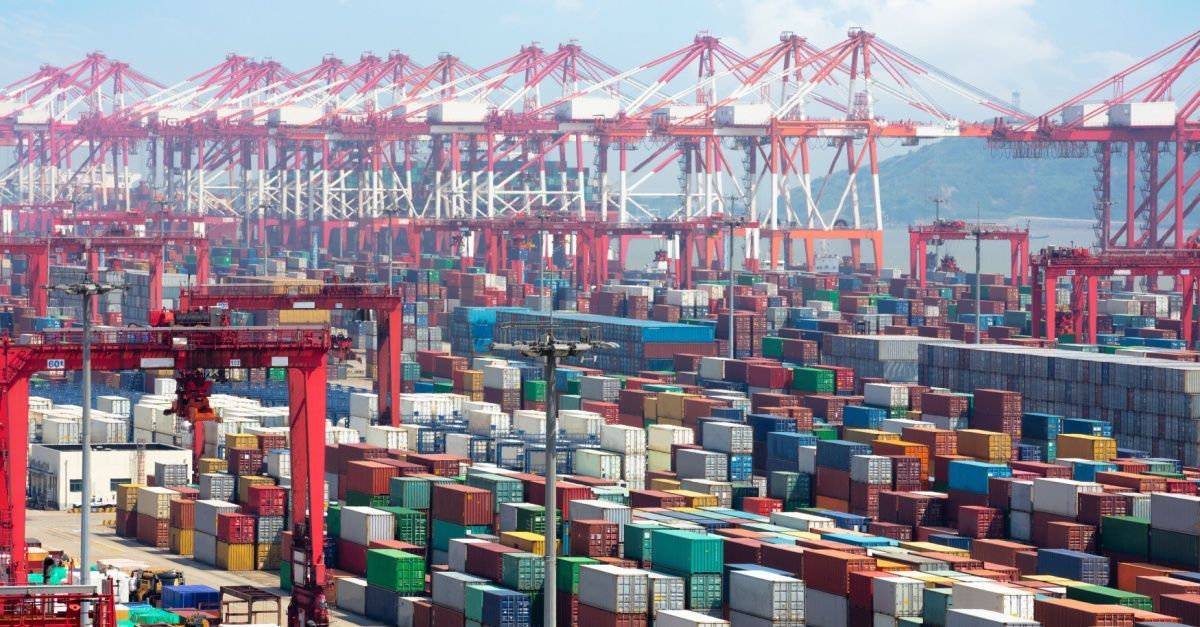Import Spikes from Tariffs Pressure Ports and Cross-Border Crossings
Blog Post CTA
The freight and logistics market has been navigating a turbulent spring as trade policy swings, supply chain bottlenecks, and shifting consumer behavior ripple through every link of the global network.
From record layoffs in retail to volatility in Mexican cross-border shipments, the industry is feeling the heat. And port operators, warehouse managers, and transportation carriers alike are having to adapt to rapid changes in container flows,
tariff impacts, and regulatory shifts.
We have unpacked the critical developments around the freight world, each reflecting the delicate balance between capacity, demand, and regulation that supply chain leaders must navigate. Continue reading to find out more.
Tariff Volatility Fuels Cross-Border Freight Swings
U.S. shippers face erratic cross-border freight flows from Mexico as tariff uncertainties continue to disrupt their logistics and supply chain planning. According to the Bureau of Transportation Statistics, U.S.-bound truck crossings rose 10.2% in January, fell 6.3% in February, spiked 12% in March, and dropped again by 4.5% in April.
Averitt’s Edward Habe attributes this volatility to shippers’ attempts to beat tariff deadlines and navigate unpredictable trade announcements. Although a 25% tariff applies only to goods outside USMCA rules of origin, shippers remain cautious.
At Eagle Pass, Texas, beer demand drove a 49.2% year-over-year surge in northbound trucks in Q1, and a considerable part of this was because of Constellation Brands’ Modelo shipments. Meanwhile, Otay Mesa’s volume plummeted 34.9% due to tariffs on Chinese and Southeast Asian imports, which impacted Mexican assembly plants.
Key crossings like Laredo and El Paso posted modest declines, while Nogales, Arizona, saw a 4.4% gain. Experts have cautioned that cross-border trade will remain turbulent as long as tariffs fluctuate, making forecasting and operational planning challenging.
Chassis Providers Mobilize for Import Surge
With U.S. ports bracing for an influx of Chinese imports, America’s largest marine chassis providers — TRAC Intermodal, DCLI, and FlexiVan — are pulling tens of thousands of units from storage, inspecting, and repositioning them to key inland hubs like Chicago, Dallas, and Memphis.
TRAC’s Val Noel said, “It could be like a tsunami,” as companies aim to avoid service disruptions. TRAC and DCLI are working closely with BNSF and Union Pacific to anticipate container volumes. FlexiVan, exiting Southern California’s Pool of Pools, is focusing on core partner Ocean Network Express and opened a new chassis pool at the ports of Los Angeles and Long Beach.
Logistics providers say it takes weeks to inspect and repair stored chassis, a process they have accelerated since learning lessons during the pandemic. Private chassis pools and railroad container management have improved since the COVID-19 pandemic, reducing pressure on public chassis pools.
However, with a surge expected this summer, providers are racing to ensure sufficient capacity and avoid bottlenecks that plagued past import booms.
Forecast Points to Port Volatility Ahead
U.S. retailers are anticipating a temporary surge in port activity this summer, driven by the 90-day U.S.-China tariff pause that slashed rates on Chinese goods from 145% to 30%.
According to the National Retail Federation’s Global Port Tracker, this pause has prompted a rush to restock, with volumes rebounding in June to an estimated
2.01 million TEUs, despite being down 6.2% year over year. However, April’s peak at 2.21 million TEUs was short-lived, with May volumes projected to drop to 1.91 million TEUs, the lowest since December 2023.
Retailers are also front-loading back-to-school and winter holiday orders, creating an unusual overlap of peak seasons. Yet, forecasts for September and October show sharp declines of 21.8% and 19.8%, respectively.
With port labor strikes and tariff policy swings in play, importers face a turbulent second half of 2025, highlighting the challenges of managing global supply chains in an unpredictable trade environment.
Tariff Whiplash Sparks Supply Chain Disruptions
April saw the largest recorded monthly drop in the U.S. trade deficit, driven by a 16% import plunge after a tariff-driven order surge. The numbers highlight a troubling supply chain crunch. Data shows warehouse inventories are bloated while replenishment orders stall, widening the gap between inventory levels and costs to 26.8 points, the third highest on record.
With storage fees still climbing, small businesses are particularly squeezed, says Colorado State’s Zachary Rogers. Freight rates on the China-U.S. route spiked 88%, with container spot rates expected to peak in June before easing.
Flexport’s Ryan Petersen warns that stacked tariffs (some containers face 70% total duties) add layers of uncertainty. Smaller logistics providers, representing the “middle mile,” are hit hardest as large players hoard capacity.
C.H. Robinson and Flexport offer tech solutions that help with tariff simulation, but July’s potential tariff increase continues to add uncertainty. The bottom line is that small and mid-tier firms bear the brunt of tariff swings, threatening their viability in an increasingly volatile trade environment.
LTL Market Faces Soft Demand as Tonnage Declines
Tonnage fell in May for multiple carriers. According to initial reports from Old Dominion Freight Line, Saia, and XPO, sluggish demand persisted in the market. LTL tonnage per day and shipments for these firms all declined compared to a year ago.
However, the severity of the drops varied, with Old Dominion hit the hardest and Saia receding the least among the group. In contrast, ArcBest’s asset-based segment reported a 6% year-over-year increase in total tons per day for the month. That came as daily shipments were up 7% for May, “reflecting success in capturing new core business,” the company said.
Saia bucked the trend, growing LTL weight per shipment by 3% year over year in May. Manufacturing woes and the customer makeup of these carriers are affecting their tonnage and weight changes.
Experts say
LTL carriers are navigating a low-demand environment by focusing on profitable lanes and contractual freight rather than chasing volume with pricing concessions.
Tariff-Driven Trade Shifts Threaten West Coast Ports
U.S. ports are navigating a shifting trade landscape as importers look to sidestep tariffs on Chinese goods, driving cargo diversification toward Southeast Asia and India. According to Larry Gross of Gross Transportation Consulting, the U.S. West Coast, which handled 57% of Chinese imports in 2024, is expected to lose the most as trade reroutes.
Chinese volumes accounted for 65% of West Coast port traffic, while only 27% and 8% went to the East and Gulf coasts, respectively. Southeast Asian imports already account for 32% of 2024 TEUs, offering some relief, but not enough to offset the decline from China.
When shippers pivot to India, the East Coast captures 86% of inbound freight, reinforcing its resilience. Additional shifts in supply chains, such as labor-related cargo diversions and closures of the Red Sea and Suez Canal, further complicate port planning.
Gross warns that the West Coast faces a “triple-barreled threat” of lower trade volumes, loss of diverted cargo to the East and Gulf coasts, and the erosion of Chinese import dominance.
Retail Layoffs Surge 274% Amid Tariffs, Economic Pessimism
U.S. retailers cut nearly 76,000 jobs in the first five months of 2025. A 274% surge over the same period in 2024, driven by tariffs, economic pessimism, and shifting consumer spending patterns.
According to Challenger, Gray & Christmas, retail ranked second in total job cuts, behind only government losses.
May alone saw 11,483 layoffs in retail, up from 7,235 in April, reflecting industrywide struggles. Andrew Challenger, senior vice president at the firm, attributed the trend to tariffs, funding cuts, and economic headwinds that have forced companies to tighten budgets.
Major brands like Nike, Walmart, and Procter & Gamble announced significant layoffs in May, with Nike shifting responsibilities within its global tech team, Walmart trimming 1,500 positions in tech and operations, and P&G slashing 7,000 nonmanufacturing jobs, which is about 15% of its workforce.
Despite the cuts, overall U.S. employment grew by 139,000 in May, with the unemployment rate holding steady at 4.2%. Challenger noted that while some companies continue to hire, they do so cautiously, reflecting a challenging macroeconomic backdrop.
Experience Seamless Shipping with Entourage Freight Solutions
Entourage Freight Solutions believes in total transparency in the shipping process. That is why we invest in tech solutions that track every shipment extensively, monitor every driver, and extract every bit of efficiency without sacrificing quality.
Our state-of-the-art platform utilizes cloud-based GPS tracking to keep you informed, reroutes shipments on the fly to avoid delays, and even responds to real-time market changes to ensure you receive your shipment on time and as soon as possible.
Our Services
- Full Truckload (FTL): When you need a truck all to yourself.
- Less-Than-Truckload (LTL): Efficient solutions for multi-stop shipments or combining smaller loads to save on costs.
- Refrigerated Trucking: Keeping your temperature-sensitive products fresh and safe.
- Cross-Docking: Strategically located facilities in Shelby, Ohio, Cedar Rapids, Iowa, and Romulus, Michigan, for streamlined consolidation, storage, and distribution.
Ready to experience a new level of service and control in your freight shipping? Request a quote today to see how Entourage Freight Solutions can help with your freight movement and other supply chain needs.









